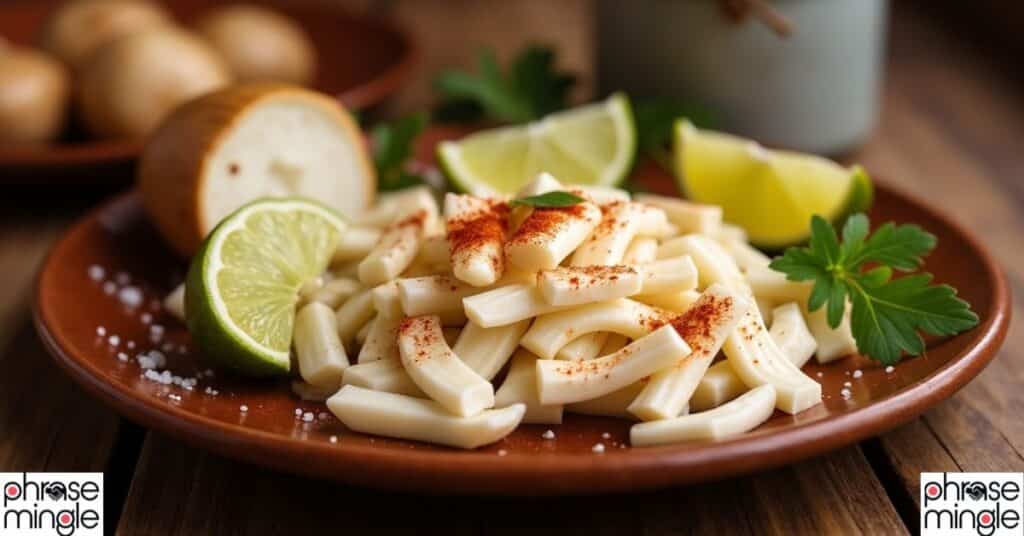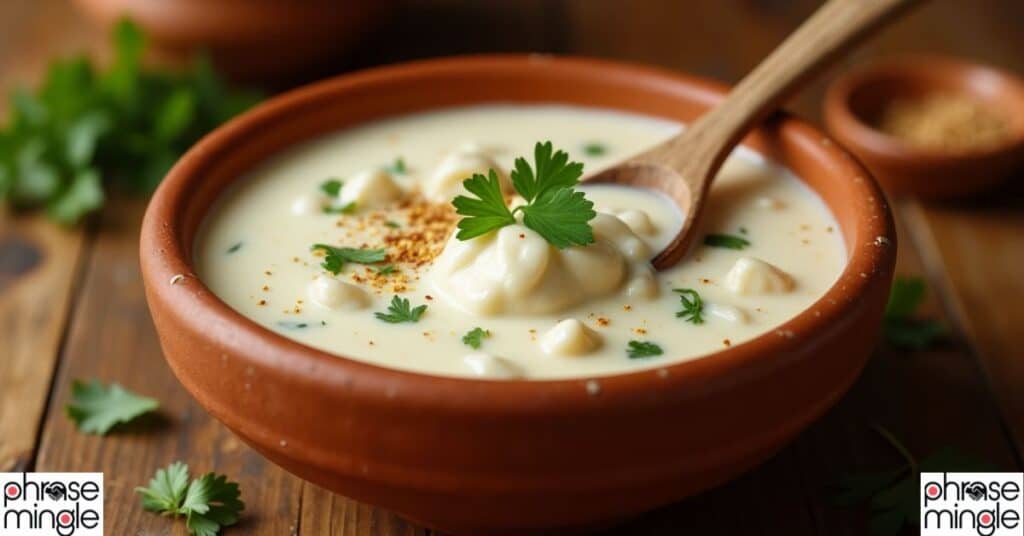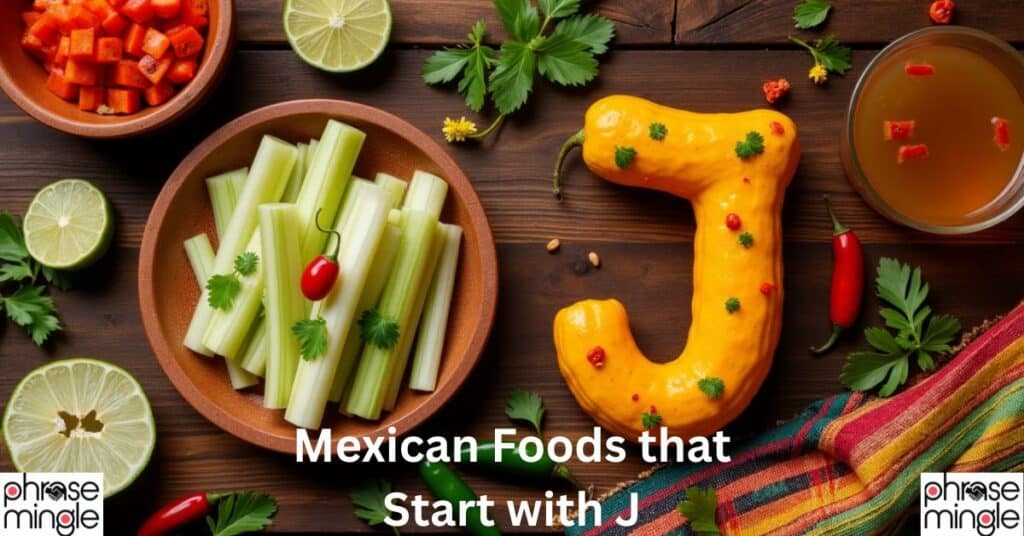Mexican Foods that Start with J go far beyond the familiar jalapeño. Mexico’s culinary world bursts with bold flavors, rich history, and deep regional pride. From the crisp bite of jicama to the creamy indulgence of jericallas, these J-foods add vibrant character to traditional dishes across the country.
Ever tried jumiles edible bugs enjoyed in Oaxaca? Or jocoque, a tangy, fermented dairy treat that puts regular sour cream to shame? These ingredients don’t just taste great they tell stories of ancient cultures, indigenous wisdom, and evolving local flavors. Every bite brings something unexpected, delicious, and deeply Mexican.
This guide uncovers 20 authentic Mexican foods that start with J, showing you how they’re made, where to find them, and why they remain essential to Mexico’s diverse and flavorful cuisine.
1. The Foundation: Chiles & Vegetables in Mexican Foods
Mexican cuisine’s foundation rests on fresh produce that has sustained civilizations for millennia. These vegetables and chiles form the backbone of countless Mexican dishes, providing everything from heat and crunch to essential nutrients that kept entire populations thriving.
Jalapeño: Mexico’s Most Famous Export
The jalapeño stands as Mexico’s most internationally recognized chili pepper, yet most people only know its mildest commercial version. Named after Xalapa, Veracruz, where it was traditionally grown, this spicy pepper ranges from 2,500 to 8,000 Scoville units though Mexican varieties often pack more heat than their American counterparts.
Traditional Mexican jalapeños come in several varieties:
- Jalapeño Típico: The classic green variety with moderate heat
- Jalapeño Rayado: Striped variety with intensified flavor
- Jalapeño Espinalteco: Darker, spicier version from Puebla
Smart Mexican cooks know that jalapeno recipes aren’t just about heat they’re about balancing sweetness, acidity, and smokiness. When jalapeños are smoked and dried, they become chipotles, transforming their bright green sharpness into complex, earthy depth.
Jalapeno health benefits include high vitamin C content (more than oranges), capsaicin for metabolism boosting, and antioxidants that support heart health. Street vendors throughout Mexico stuff them with cheese, batter them, and deep fry them for chiles rellenos that put restaurant versions to shame.
Jicama: The Crispy Water Chestnut Alternative

Jicama (pronounced HEE-kah-mah) serves as Mexico’s answer to the water chestnut a crispy, refreshing root vegetable that’s technically a yam bean. This Mexican turnip grows underground, developing a papery brown skin that conceals sweet, white flesh with the texture of a crisp apple.
Street vendors across Mexico slice jicama into sticks and sprinkle them with:
- Tajín: Chili lime seasoning
- Limón: Fresh lime juice
- Sal: Coarse salt
- Chile piquín: Tiny, fiery ground chiles
Jicama health benefits are impressive it’s packed with vitamin C, fiber, and potassium while remaining extremely low in calories. Unlike potatoes or other starchy vegetables, jicama stays crispy even when cooked, making it perfect for stir fries and salads.
Jicama recipes extend beyond simple snacking. In Yucatán, cooks add it to salpicón (a refreshing salad with shredded meat). Oaxacan markets feature jicama in fruit salads with watermelon, pineapple, and cucumber, all dressed with lime and chile.
IF YOU WANT TO READ ABOUT DRINKS TAHAT START WITH ‘S’ CLICK HERE
Jitomate: Mexico’s Original Tomato
Jitomate represents Mexico’s gift to the world the original tomato that transformed global cuisine. The word comes from Nahuatl “xitomatl,” distinguishing it from “tomatl” (the green tomatillo). These Mexican tomatoes taste nothing like the watery, uniform versions found in most supermarkets.
Heirloom jitomate varieties still grown in Mexico include:
- Jitomate Bola: Large, meaty tomatoes perfect for slicing
- Jitomate Saladette: Elongated variety ideal for sauces
- Jitomate Cherry: Tiny, intensely flavored versions
Jitomate dishes form the foundation of Mexican cooking. The famous salsa roja starts with charred jitomates, roasted over open flames until their skins blacken and blister. This technique, called “tatemado,” creates smoky depth impossible to achieve with raw tomatoes.
Jitomate health benefits include lycopene for heart health, vitamin K for bone strength, and folate for cellular function. Mexican grandmothers have long used jitomate juice as a natural remedy for digestive issues and skin problems.
Jengibre: Mexico’s Medicinal Spice
Jengibre (Mexican ginger) arrived during the colonial period but became thoroughly integrated into Mexican cuisine and traditional medicine. Unlike the harsh bite of commercial ginger, Mexican jengibre tends to be more aromatic and less aggressive.
Mexican dishes featuring jengibre include:
- Té de jengibre: Ginger tea with honey and lime
- Agua fresca de jengibre: Refreshing ginger water
- Jengibre cristalizado: Crystallized ginger candy
Traditional healers throughout Mexico prescribe jengibre for digestive problems, nausea, and respiratory issues. It’s commonly combined with other medicinal plants in remedios caseros (home remedies) that have been passed down through generations.
2. The Substance: Proteins & Seafood in Mexican Cuisine
Mexico’s extensive coastlines and diverse ecosystems provide an abundance of protein sources that many outside the country never encounter. These proteins showcase the country’s connection to both land and sea, from ancient insect traditions to coastal fishing practices.
Jaiba: Gulf Coast Blue Crab Delicacy
Jaiba (blue crab) represents one of Mexico’s most prized seafood treasures, especially along the Gulf of Mexico coast. These crabs are smaller than their American counterparts but pack incredible flavor that makes them worth the extra effort required to extract their meat.
Veracruz fishermen catch jaiba using traditional methods passed down through generations. The crabs hide in mangrove roots and shallow waters, requiring intimate knowledge of tidal patterns and crab behavior. Peak season runs from September through February when the crabs are fattest and most flavorful.
Popular jaiba preparations include:
- Jaibas rellenas: Stuffed crab shells with seasoned crabmeat
- Sopa de jaiba: Rich crab soup with vegetables
- Empanadas de jaiba: Crab turnovers with spicy filling
The secret to perfect jaiba lies in gentle cooking that preserves the delicate sweetness. Mexican cooks often steam them with beer, garlic, and bay leaves, then serve them with spicy mayonnaise mixed with chipotle peppers.
Jurel: Pacific Coast Jack Fish
Jurel (jack fish) swimming in Mexico’s Pacific waters provide an affordable, sustainable protein that’s central to coastal Mexican cuisine. These silvery fish offer firm, mild flesh that works perfectly in ceviches, grilled preparations, and traditional fish tacos.
Mexican fishermen prize jurel for its versatility and year round availability. Unlike more expensive fish, jurel remains accessible to working class families while providing excellent nutrition and flavor. The fish’s firm texture holds up well to acidic marinades, making it ideal for ceviche.
Traditional jurel preparations include:
- Ceviche de jurel: Raw fish “cooked” in lime juice
- Jurel a la plancha: Grilled with garlic and herbs
- Jurel en escabeche: Pickled with onions and jalapeños
The key to great jurel lies in absolute freshness. Mexican coastal markets sell them hours after catching, their eyes still clear and flesh still firm. This immediacy creates flavors impossible to replicate with frozen fish.
Jumiles: Oaxaca’s Ancient Protein Source
Jumiles (stink bugs) represent one of Mexico’s most misunderstood foods a protein source that sustained indigenous populations long before European colonization. These edible insects, harvested from oak trees in Oaxaca’s mountains, offer a nutty, slightly mineral flavor that’s nothing like their intimidating appearance suggests.
Jumiles health benefits are remarkable they’re 70% protein, rich in iron and zinc, and provide all essential amino acids. From a sustainability perspective, they require no feed, water, or land, making them one of the most environmentally friendly proteins available.
Traditional jumiles dishes include:
- Jumiles tostados: Toasted with garlic and salt
- Salsa de jumiles: Ground into spicy sauce
- Tacos de jumiles: Served in corn tortillas with salsa verde
Harvesting jumiles requires specific timing and techniques. Collectors gather them from oak trees during rainy season, when the bugs are fattest and most flavorful. The insects are typically eaten alive (they’re said to taste better) or quickly toasted to preserve their crunchiness.
3. The Refreshment: Fruits & Natural Sweets in Mexican Foods
Mexico’s tropical and subtropical regions produce an incredible variety of fruits that most people outside the country never encounter. These natural sweets provide essential vitamins, unique flavors, and refreshing relief from the country’s often intense heat.
Jocote: Central American Influence
Jocote (hog plum) represents the cultural exchange between Mexico and Central America, where this small, tart fruit plays a more prominent role. In southern Mexico, particularly Chiapas, jocote appears in markets during its brief season from August through October.
The fruit resembles a small plum but offers a more complex flavor profile simultaneously sweet, sour, and slightly astringent. Jocote flavors vary significantly depending on ripeness, with green fruits being extremely sour and red ripe ones developing sweetness that balances the tartness.
Traditional jocote uses include:
- Agua de jocote: Refreshing fruit water
- Jocote en salmuera: Pickled in brine with chiles
- Dulce de jocote: Candied fruit preserve
Jocote recipes often involve salt and chile powder, which enhance the fruit’s natural flavors while providing the sweet sour spicy combination that Mexicans love. Street vendors serve them sliced with lime juice, salt, and chile piquín.
Jobo: Tropical Golden Treasure
Jobo (yellow mombin) grows throughout Mexico’s tropical regions, producing golden fruits that look like small mangoes but taste completely different. These fruits offer a resinous, pine like flavor that’s unlike any other tropical fruit polarizing but unforgettable.
The jobo tree produces fruit sporadically throughout the year, with peak season during the rainy months. Indigenous communities have used every part of the tree the bark for medicine, the leaves for tea, and the fruit for food and beverages.
Jobo dishes include:
- Agua de jobo: Fermented fruit drink
- Jobo en miel: Fruit cooked in honey
- Salsa de jobo: Spicy fruit sauce
Traditional preparation methods involve allowing the fruit to ferment slightly, which mellows its intense flavor and creates a mildly alcoholic beverage that’s been consumed for centuries.
Jaca: The New Tropical Addition of 20 Mexican Foods that Start with J
Jaca (jackfruit) represents a relatively recent addition to Mexican cuisine, introduced from Southeast Asia but finding new life in Yucatán’s tropical climate. This massive fruit sometimes weighing over 80 pounds produces sweet, custard like flesh that’s becoming increasingly popular.
Unlike its native habitat, where jackfruit is often eaten young as a vegetable, Mexican cooks focus on the ripe fruit’s sweetness. Jaca flesh has a texture similar to pulled pork, making it popular among vegetarians looking for meat substitutes.
Growing jaca popularity in Mexico stems from:
- Versatility: Works in sweet and savory dishes
- Sustainability: Massive yield from single fruit
- Nutrition: High in vitamin C and fiber
- Unique flavor: Sweet, tropical taste unlike other fruits
Mexican preparations include agua de jaca (jackfruit water), jaca en almíbar (fruit in syrup), and even tacos de jaca where the fruit substitutes for meat.
IF YOU WANT TO READ ABOUT BREAKFAST THAT START WITH ‘B’ CLICK HERE
4. The Creamy: Dairy & Fermented Foods in Mexican Cuisine
Mexico’s dairy traditions blend indigenous techniques with Spanish colonial influences, creating unique fermented products that enhance countless Mexican dishes. These creamy additions provide richness, tang, and complexity that define authentic Mexican flavors.
Jocoque: Mexico’s Superior Sour Cream

Jocoque stands as Mexico’s answer to sour cream, but with significantly more character and complexity. This fermented milk product offers a tangy, slightly effervescent quality that makes regular sour cream taste flat and boring by comparison.
Traditional jocoque production involves culturing whole milk with specific bacterial strains that create its distinctive flavor and texture. The fermentation process can take anywhere from 12 to 24 hours, depending on temperature and desired tanginess.
Regional jocoque variations include:
- Jocoque seco: Thick, cheese like consistency
- Jocoque líquido: Pourable, drink like version
- Jocoque con hierbas: Flavored with herbs and spices
Jocoque recipes span from simple jocoque dips with herbs and garlic to complex Mexican sauces that accompany grilled meats. The key advantage over regular sour cream lies in jocoque’s ability to enhance rather than mask other flavors.
Jocoque dips commonly feature:
- Chipotle: Smoky heat from dried jalapeños
- Cilantro: Fresh herb brightness
- Lime: Acidic balance
- Garlic: Aromatic depth
Jamoncillos: Caramelized Milk Candy Perfection
Jamoncillos represent Mexico’s mastery of caramelized milk candy, similar to dulce de leche candy but with a firmer texture and more complex flavor development. These small, fudge like squares showcase the country’s sophisticated approach to confectionery.
The name jamoncillos (little hams) comes from their traditional rectangular shape and brownish color, though modern versions come in various forms. Jamoncillos flavors range from classic vanilla to innovative combinations with nuts, coconut, or fruit.
Traditional jamoncillos preparation requires:
- Fresh milk: Preferably from local dairies
- Sugar: Cane sugar for authentic flavor
- Patience: Slow cooking for proper caramelization
- Skill: Knowing when to stop cooking
Jamoncillos variations include:
- Jamoncillos de leche: Classic milk version
- Jamoncillos de coco: Coconut flavored
- Jamoncillos de nuez: With pecans or walnuts
- Jamoncillos de cajeta: Made with goat’s milk caramel
The secret to perfect jamoncillos lies in temperature control and timing. Experienced candy makers can tell by sound and smell when the mixture reaches the proper consistency too little cooking results in soft candy that won’t hold its shape, while overcooking creates hard, brittle squares.
5. The Liquid Culture: Traditional Mexican Drinks
Mexico’s beverage traditions span from ancient indigenous drinks to modern commercial innovations, each reflecting the country’s complex relationship with refreshment, celebration, and daily sustenance. These liquid treasures showcase Mexico’s creativity in transforming simple ingredients into complex flavors.
Jarritos: Mexico’s Iconic Soda Brand
Jarritos represents more than just another soda brand it’s a cultural institution that’s been refreshing Mexico since 1950. These Mexican sodas offer fruit flavored sodas that taste like actual fruit rather than artificial chemicals, setting them apart from international competitors.
Jarritos flavors include some varieties unavailable anywhere else:
- Tamarindo: Tangy tamarind pod flavor
- Guava: Tropical sweetness
- Pineapple: Fresh, not artificial
- Lime: Crisp citrus brightness
- Mandarin: Subtle orange complexity
Jarritos ingredients focus on real fruit flavors and cane sugar rather than high fructose corn syrup, creating a cleaner taste that doesn’t leave the cloying aftertaste associated with many sodas. The brand’s commitment to authentic flavors has made it popular among Mexican Americans seeking tastes from home.
The distinctive clay colored bottles and vibrant labels make Jarritos instantly recognizable throughout Mexico and increasingly in the United States. These traditional Mexican drinks pair perfectly with spicy food, their fruit flavors providing cooling relief from chile heat.
Agua de Jamaica: Hibiscus Water Perfection
Agua de Jamaica (hibiscus water) stands as one of Mexico’s most refreshing and healthiest beverages, made from dried hibiscus flowers that create a beautiful ruby red drink with tart, cranberry like flavor. This traditional Mexican drink appears at every taco stand, restaurant, and home throughout the country.
The preparation of agua de Jamaica seems simple but requires specific techniques for optimal flavor:
- Proper steeping time: 10 15 minutes for full extraction
- Sugar balance: Enough to offset tartness without masking flavor
- Temperature: Served ice cold for maximum refreshment
- Freshness: Best consumed within 24 hours
Health benefits of agua de Jamaica include:
- High antioxidants: Protects against cellular damage
- Natural diuretic: Supports kidney function
- Blood pressure support: May help lower hypertension
- Vitamin C: Immune system boost
Mexican families often prepare large batches of agua de Jamaica for gatherings, serving it alongside agua de horchata and agua de tamarindo to provide variety. The drink’s natural tartness makes it particularly refreshing in hot weather, while its deep red color adds visual appeal to any meal.
Jabalí Mezcal: Wild Boar Artisanal Spirit
Jabalí Mezcal represents the pinnacle of artisanal mezcal production, made from wild agave plants that grow in Mexico’s harsh mountainous regions. This artisanal mezcal offers complex flavors that reflect the terroir of its high altitude origins and the skill of traditional mezcaleros.
Unlike commercial mezcals, Jabalí (wild boar) gets its name from the agave’s resemblance to a wild boar’s bristly appearance. These plants take 15-20 years to mature, developing intense flavors that create some of Mexico’s most prized spirits.
Jabalí mezcal production follows ancient techniques:
- Hand harvesting: Agave hearts cut with traditional tools
- Stone grinding: Tahona wheels crush cooked agave
- Clay pot distillation: Traditional copper or clay stills
- Natural fermentation: Wild yeasts create unique flavors
Tasting notes for quality Jabalí mezcal include:
- Smoke: From underground roasting pits
- Earth: Mineral notes from mountain soils
- Fruit: Subtle tropical fruit undertones
- Spice: Black pepper and chile hints
- Herbs: Wild mountain vegetation influences
The artisanal production methods result in limited quantities and higher prices, but the complexity and authenticity make Jabalí mezcal worth seeking out for serious spirits enthusiasts.
6. Regional Specialties & Authentic Mexican Foods that Start with J
Mexico’s regional diversity creates distinct culinary traditions that vary dramatically from north to south and coast to mountains. These regional specialties represent the authentic heart of Mexican cuisine, showcasing techniques and flavors that have been perfected over generations.
Jericallas: Guadalajara’s Crème Brûlée
Jericallas represent Guadalajara’s most famous dessert contribution to Mexican cuisine, a custard dessert that predates European crème brûlée by several centuries. This Mexican custard Foods that Start with J offers a perfect balance of creamy interior and caramelized top that makes it irresistible to anyone with a sweet tooth.
The origin story of jericallas involves a Spanish nun who arrived in Guadalajara and adapted European custard techniques to local ingredients and tastes. The result became so popular that it spread throughout Jalisco and beyond, becoming one of Mexico’s most beloved Mexican dessert recipes.
Jericallas ingredients include:
- Fresh milk: Preferably from local dairies
- Eggs: Free range for richest flavor
- Sugar: Cane sugar for authentic taste
- Vanilla: Real vanilla extract, not artificial
- Cinnamon: Mexican canela for aromatic depth
Jericallas flavors can be enhanced with:
- Coconut: Shredded coconut for tropical notes
- Coffee: Espresso for adult sophistication
- Chocolate: Mexican chocolate for richness
- Fruit: Seasonal fruits for variety
The technique differences between jericallas and crème brûlée center on texture and preparation. Jericallas are typically baked in individual clay pots called jarritos, which create a rustic appearance and slightly different texture from the smooth French version.
Jochos: Street Food Evolution
Jochos represent the fascinating evolution of street food, showing how Mexican vendors adapted foreign influences to create something uniquely their own. These elaborate hot dogs feature multiple toppings and preparations that make American hot dogs look simple by comparison.
Originally influenced by Central American street food traditions, jochos have evolved into complex creations that showcase Mexican creativity with simple ingredients. Street food evolution continues as vendors experiment with new toppings and preparation methods.
Typical jocho toppings include:
- Refried beans: Protein and substance
- Pico de gallo: Fresh tomato salsa
- Guacamole: Creamy avocado richness
- Pickled vegetables: Tangy contrast
- Multiple salsas: Various heat levels
- Cheese: Melted or crumbled
The Mexican adaptations of this street food include using bolillo bread instead of standard hot dog buns, adding beans for protein, and incorporating traditional Mexican salsas and garnishes. These modifications create a more substantial meal that reflects Mexican flavor preferences.
7. These Thrive Mexican Foods that Start with J
Understanding where these Mexican foods originate helps appreciate their cultural significance and authentic preparation methods. Each region of Mexico contributes unique ingredients and techniques that reflect local climate, history, and cultural influences.
Northern Mexico: Gulf Coast Treasures
Northern Mexico along the Gulf of Mexico produces some of the country’s finest seafood, with jaiba (blue crab) representing the region’s crown jewel. The warm, shallow waters of the Gulf create perfect conditions for these crabs, which develop exceptional flavor and texture.
Veracruz serves as the epicenter of Mexican seafood culture, where fishing families have perfected techniques for catching and preparing jaiba for generations. The city’s markets overflow with fresh seafood, and local restaurants showcase preparations that highlight the natural sweetness of Gulf waters.
Regional specialties from Northern Mexico include:
- Jaibas rellenas: Stuffed crab shells with seasoned meat
- Caldos de mariscos: Seafood soups with local catch
- Pescado a la veracruzana: Fish in tomato based sauce
Central Highlands: Traditional Dessert Capital
Central Mexico around Guadalajara and surrounding areas produces the country’s most refined desserts, with jericallas leading the way. The region’s dairy traditions, combined with Spanish colonial influences, created a perfect environment for developing sophisticated sweets.
Jalisco in particular showcases Mexico’s dessert mastery, with local jamoncillos producers creating candies that rival European confections. These Mexican desserts reflect the region’s prosperity and access to quality ingredients.
Traditional techniques preserved in Central Mexico include:
- Clay pot baking: For authentic jericallas texture
- Slow milk caramelization: For perfect jamoncillos
- Temperature control: Critical for consistent results
Southern Tropics: Fruit Paradise
Southern Mexico including Chiapas, Oaxaca, and Yucatán produces fruits like jocote and jobo that rarely appear in other regions. The tropical climate and diverse ecosystems create perfect conditions for these unique fruits.
Oaxaca also serves as the epicenter of jumiles culture, where indigenous communities maintain traditional harvesting and preparation methods. The state’s commitment to preserving ancient food traditions makes it a treasure trove for authentic Mexican cuisine.
Seasonal availability varies significantly:
- Jocote: August through October
- Jobo: Rainy season months
- Jumiles: September through November
Coastal Regions: Fresh Seafood Mastery
Pacific Coast regions excel at preparing jurel and other fish, with techniques that emphasize freshness and simple preparation methods. Coastal communities have developed relationships with local fishermen that ensure access to the day’s best catch.
Coastal preparation methods focus on:
- Immediate preparation: Fish cooked within hours of catching
- Simple seasonings: Letting fish flavors shine
- Traditional techniques: Methods passed down through generations
IF YOU WANT TO READ ABOUT GIN AND SPRITE CLICK HERE
8. Quick Reference: Your Mexican Foods J-Guide
To help you navigate these Mexican foods that start with J, here’s essential information for pronunciation, availability, and practical tips.
Pronunciation Guide
| Food | Pronunciation | Origin |
|---|---|---|
| Jalapeño | hah-lah-PEH-nyoh | Xalapa, Veracruz |
| Jicama | HEE-kah-mah | Nahuatl |
| Jericallas | heh-ree-KAH-yahs | Guadalajara |
| Jocoque | hoh-KOH-keh | Spanish colonial |
| Jumiles | hoo-MEE-lehs | Oaxaca |
| Jamoncillos | hah-mohn-SEE-yohs | Various regions |
| Jitomate | hee-toh-MAH-teh | Nahuatl |
| Jaiba | HAH-ee-bah | Gulf Coast |
Seasonal Availability Calendar
| Month | Available Foods | Peak Season |
|---|---|---|
| January-March | Jaiba, Jurel, Jengibre | Jaiba peak |
| April-June | Jicama, Jitomate, Jarritos | Jitomate peak |
| July-September | Jocote, Jobo, Jumiles | Tropical fruits |
| October-December | Jamoncillos, Jericallas | Holiday sweets |
Storage and Preparation Tips
Fresh Ingredients:
- Jicama: Store in refrigerator up to 2 weeks
- Jalapeños: Freeze whole for longer storage
- Jitomate: Ripen at room temperature, then refrigerate
Prepared Foods:
- Jocoque: Use within 1 week of opening
- Jamoncillos: Store in airtight container
- Jericallas: Best served fresh, refrigerate leftovers
Emergency Substitutions
When you can’t find authentic ingredients, these substitutions work:
- Jicama: Use daikon radish or water chestnuts
- Jocoque: Substitute Greek yogurt mixed with lime
- Jitomate: Use best available tomatoes, preferably heirloom
- Jalapeños: Serrano peppers for more heat
9. Conclusion: Your Next Culinary Adventure with Mexican Foods
These 20 Mexican foods that start with J represent just a fraction of Mexico’s incredible culinary diversity. From the familiar jalapeño to the jumiles, each ingredient tells a story of cultural exchange, regional pride, and culinary innovation that spans centuries.
Mexican cuisine offers far more complexity than most people realize. Behind every taco stand and family kitchen lies a tradition of techniques, flavors, and ingredients that have been refined over generations. Understanding these traditional Mexican recipes provides insight into a culture that values food not just as sustenance, but as connection to history, community, and identity.
Your challenge for the next month: try at least three of Mexican Foods that Start with J you’ve never experienced before. Start with easily accessible options like jicama from your local Mexican market, then work your way up to more adventurous choices like jocoque or even jumiles if you can find them.
For beginners, start with:
- Jicama with lime and chile
- Agua de Jamaica from a Mexican restaurant
- Jericallas from an authentic Mexican bakery
For adventurous eaters, seek out:
- Jumiles from Oaxacan markets or specialty stores
- Jocoque from Mexican grocery stores
- Jabalí mezcal from premium spirits shops
Mexican Foods that Start with J’ just food it’s a link to culture, tradition, and community. Each dish supports local farmers, artisans, and time honored practices. From street snacks to festive desserts, every bite tells a story. So next time, go beyond the basics try jocoque, jicama, or agua de Jamaica and taste the heritage that makes Mexican food truly unforgettable.

Jamze Hope,
I am a writer at Phrase Mingle, where i shares insightful phrase guides to help readers enhance their language skills. With a passion for words and clear communication, Jamze creates engaging content that simplifies complex expressions, making them accessible to all.







